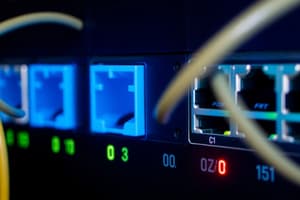Podcast
Questions and Answers
Which attribute correctly describes voice traffic?
Which attribute correctly describes voice traffic?
- Uses retransmission if packets are lost
- Greedy for bandwidth
- Sensitive to delays and drops (correct)
- Bursty in nature
What characterizes video traffic compared to voice traffic?
What characterizes video traffic compared to voice traffic?
- Is bursty due to keyframes (correct)
- Is less sensitive to bandwidth variations
- Uses TCP for retransmission
- Flows at an even rate
How does FIFO queuing manage traffic?
How does FIFO queuing manage traffic?
- Reduces response time for interactive traffic
- Allows traffic to depart in the order it arrived (correct)
- Schedules traffic based on flow characteristics
- Prioritizes high bandwidth flows
Which statement accurately describes WFQ?
Which statement accurately describes WFQ?
What is a key feature of QoS technologies?
What is a key feature of QoS technologies?
What is the primary concern for both voice and video traffic?
What is the primary concern for both voice and video traffic?
In what way is voice traffic described in terms of bandwidth usage?
In what way is voice traffic described in terms of bandwidth usage?
How does burstiness in video traffic impact its quality?
How does burstiness in video traffic impact its quality?
What distinguishes integrated services in QoS mechanisms?
What distinguishes integrated services in QoS mechanisms?
What is the consequence of voice and video traffic using UDP?
What is the consequence of voice and video traffic using UDP?
Flashcards are hidden until you start studying
Study Notes
Port Numbers
- Well-known port numbers are those below 1024.
- Dynamically assigned port numbers are above 1024.
- Registered port numbers are mainly above 1024, designated for vendor-specific applications.
Domain Name Service (DNS)
- Translates domain names into IP addresses.
- There are over 200 top-level domains on the internet.
FTP and TFTP
- FTP (File Transfer Protocol) is a connection-oriented service using TCP, ensuring reliable file transfers.
- TFTP (Trivial File Transfer Protocol) is connectionless and uses UDP, commonly used on routers for transferring configuration files.
- TFTP is designed to be small and easy to implement.
SNMP
- Simple Network Management Protocol, facilitates management information exchange between network devices.
TELNET
- Client software for logging into remote internet hosts running telnet server applications.
- Allows execution of commands from the command line interface.
Access Control Lists (ACLs)
- A Layer 3 security measure controlling traffic between routers, referred to as Packet Filtering Firewalls.
- Types of ACLs:
- Standard ACL
- Extended ACL
- Named ACL
Standard Access List
- Number range is 1-99.
- Capable of blocking network, host, and subnet traffic.
- Stops two-way communication and blocks all services.
- Implemented closest to the destination.
Configuration Commands for Access Lists
- Create a standard named access list:
Router(config)# ip access-list standard
- Implement a standard named access list:
Router(config)#interfaceRouter(config-if)#ip access-group
Extended Access List
- Create an extended named access list:
Router(config)# ip access-list extended <destination wildcard mask>
- Implementation follows similar commands as standard lists.
Bridge Basics
- Bridge ID combines bridge priority and MAC address to track all switches in the network.
- Non-root bridges exchange BPDUs with all other bridges to maintain STP topology.
Port Costs and Convergence
- Link cost determined by bandwidth.
- Path cost is the cumulative cost to the root bridge.
- BPDUs contain information about ports, costs, and priorities.
- Convergence occurs when ports transition to forwarding or blocking states. Original STP (802.1d) takes 50 seconds to transition from blocking to forwarding.
Bridge Port Roles
- Root Port: Best path to the root bridge; all non-root bridges must have this.
- Designated Port: Lowest cost to access a specific network segment.
- Non-designated Port: Highest cost, kept in a blocked state.
- Forwarding Port: Capable of forwarding frames.
- Blocked Port: Receives only BPDUs.
- Alternate and Backup Ports: Related to blocking states in STP and RSTP, respectively.
Spanning-Tree Port States
- Disabled: Non-operational state.
- Blocking: Does not forward frames; only listens to BPDUs.
Dynamic ARP Inspection (DAI)
- Works with DHCP snooping to protect against ARP poisoning by rejecting invalid ARP packets.
- Maintains a binding database of valid (MAC address, IP address) pairs.
Identity-based Networking
- Integrates several components to provide users with network services.
- IEEE 802.1x standard can be employed for identity-based networking in wired and wireless hosts.
External Authentication Options
- RADIUS: Combines authentication and authorization; follows a three-stage authentication process.
- TACACS+: Cisco's proprietary security server using TCP for authentication.
Voice and Video Traffic
-
Voice Traffic:
- Sensitive to delays/drops; uses UDP and has no retransmission for lost packets.
- Flows evenly and requires low bandwidth per call.
-
Video Traffic:
- Also sensitive to delays/drops with no retransmission.
- Characteristics include burstiness and higher bandwidth demands for better quality.
Traffic Management Algorithms
- FIFO (First In First Out): Processes traffic in the order received without prioritization.
- WFQ (Weighted Fair Queuing): Prioritizes interactive traffic for quicker response times and shares bandwidth among high-volume flows fairly.
Quality of Service (QoS) Technologies
- Enhance network services for edge applications using mechanisms such as Best Effort and Integrated Services.
Studying That Suits You
Use AI to generate personalized quizzes and flashcards to suit your learning preferences.




